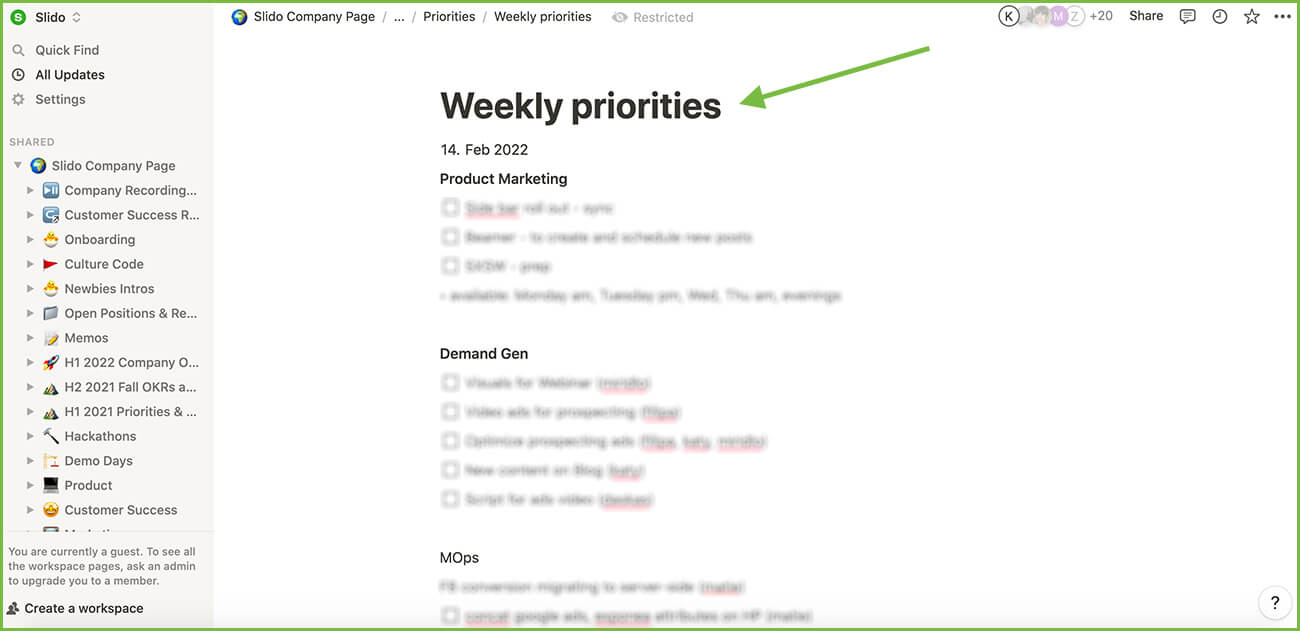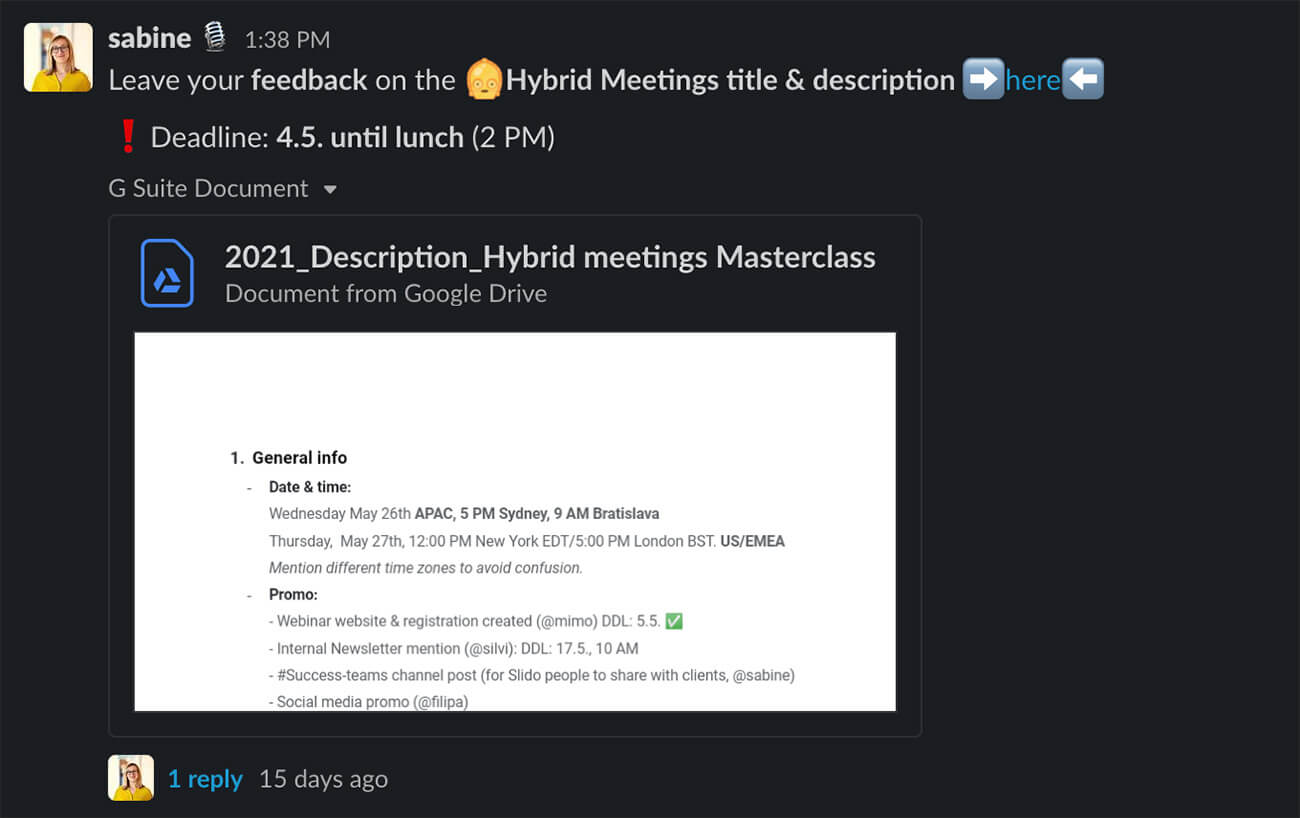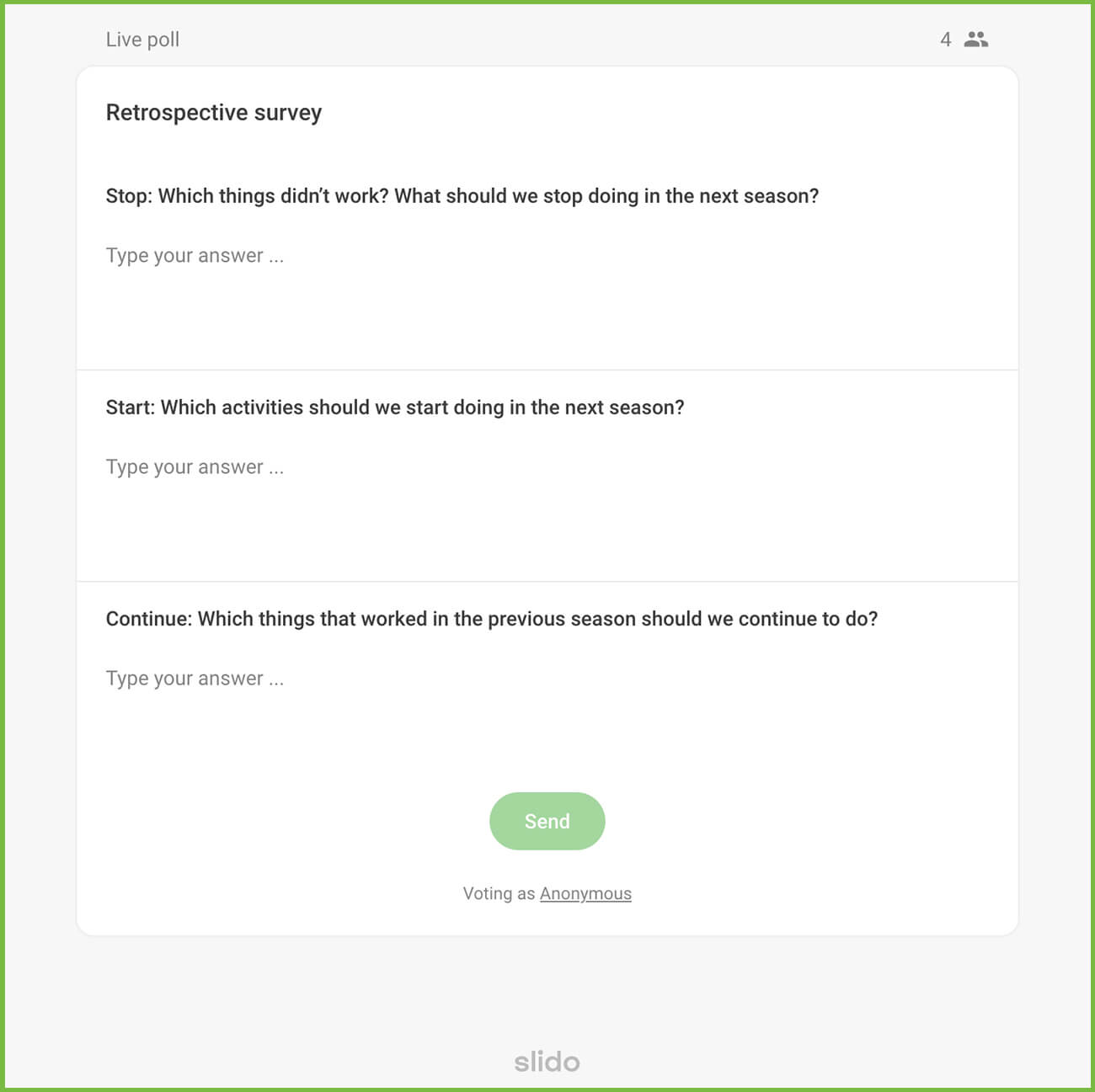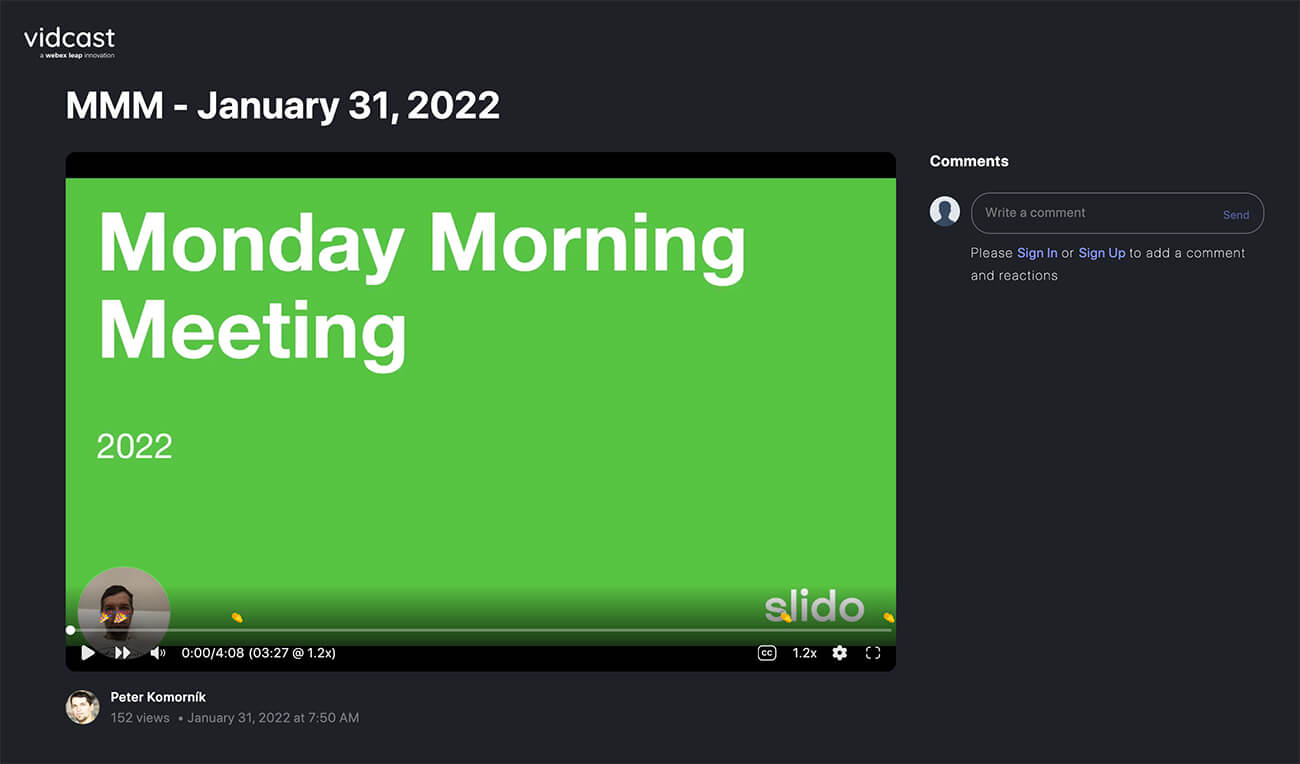As we navigate the wild waters of hybrid work, asynchronous (async) communication should definitely be on our radar.
We work more individualistically now than we ever have before.
Many professionals still work remotely. Others come to the office only once in a while.
The recent Gallup research revealed that 45% of US full-time employees work from home either all (25%) or part (20%) of the time.
The asynchronous way of communicating and working is key to more efficiency for teams that operate in a hybrid setup or are globally distributed.
Let’s explore the benefits of asynchronous communication and see how you can embrace it in your team to reach better results.
What is asynchronous communication?
Asynchronous communication is when the communicating parties exchange information at different times. In other words, it’s communication that happens outside a meeting or call.
While a meeting or a (conference) call happens in real-time – in synchronicity, – asynchronous communication allows everyone involved to share, receive and react to information whenever it suits them, without being required to respond immediately.
What are the benefits of embracing asynchronous communication?
- Does your team operate in a remote or hybrid setting?
- Are your colleagues located in different time zones or do they commute often?
- Does your workforce consist of working parents or freelancers who work on multiple projects simultaneously?
If you answered ‘yes’ to at least one of these questions, then asynchronous communication is something for you to explore. There are undeniable benefits to it.
💚 More inclusive work environment
Remote workers or childcare providers who don’t work from the office, or can’t always make it to a meeting, may often feel left out of important conversations. Working in an async way helps team leaders to make sure everyone is informed and has an equal opportunity to respond.
👍 Scalable communication & increased efficiency
Async is a sure way to communicate all the necessary information to everyone at scale. Instead of a meeting or training happening in real-time, you can deliver the necessary information via internal communication channels, or via a pre-recorded video.
⏰ Time-saving
Adopting the asynchronous way of working allows team leaders to reduce the number of meetings and save time not only for themselves but also for everyone else on the team. Communicating asynchronously may eliminate unnecessary discussions that often arise at meetings, and thus speed up the progress.
🕊 More autonomy and freedom
Fewer meetings due to communicating asynchronously mean more time for people to focus on their work. Also, giving people the chance to consume information at a time that suits them helps them schedule their time more effectively.
🙌 Empowering silent voices
Working asynchronously can empower your more introverted colleagues. If the work communication doesn’t happen in real-time, such as at a meeting, the silent ones will be much more likely to voice their opinions or raise any issues, e.g., via online communication.
Read also: Asynchronous Work Is the Future. Here’s Why.
7 ways to embrace asynchronous communication in your team
Now let’s go from theory to practice. At Slido, we’ve been working in a hybrid setup long before the pandemic, and our globally distributed team (currently 250+ people in 25+ countries) is the reason we apply an async mindset to our everyday operations.
Here are some tips on things that helped us streamline our internal communications and work more effectively as a team. Get inspired.
#1. Make the most out of your internal communications channels
Anything that you can do asynchronously, do it online – without calling a meeting. Create online spaces that all your teammates can use to stay aligned and get actively involved, whether it is on Webex, Slack, Microsoft Teams, or another platform.
Discuss everything important in there – whether it’s quick morning sync outcomes, sharing a work in progress document for review, or a “what shall we do for our team retreat?” chat.

Also, make sure to organize your internal communication space well. Of course, have your dedicated team channel where you discuss all business-as-usual matters. Apart from this, consider creating separate conversation channels for certain business areas or special projects.
For example, at Slido, we have channels such as #email_touchpoints, #marketing_requests, or #customer_newsletter, where we post updates relevant to each topic so that everyone involved is always in the loop.
💡 Tip
If a portion of your team comes to the office, while others work remotely, update your remote colleagues after an impromptu discussion takes place on-site. Simply post an update to your team channel about what was discussed so that those who weren’t physically present at the office can chip in with their thoughts and ideas.
#2. Stay on top of your project management
Update your Notion/Trello/Asana (or whichever project management tool you’re using) regularly so that everybody is aligned on the status of each task and each other’s priorities.
A great hack is to set up an automatic reminder bot in your internal communications tool for your teammates, so they don’t forget to update their dashboards.
For instance, we have a reminder set in our team’s Slack channel. Each Monday morning, it nudges us into setting our priorities for the week and reminds us to fill out the latest results in our Notion dashboard.

For larger projects, we recommend appointing someone from the team to be a project manager who’ll oversee these virtual whiteboards and keep them updated.
Make this Notion/Asana/Trello board freely accessible and available to everyone at all times so that anyone who wishes to know the status of projects will be in the know.

Read also: How to Prepare for a Meeting: Step by Step (With Examples)
#3. Run asynchronous feedback rounds
The smoothest way to collect feedback is via collaborative cloud-based documents such as G-Suite Docs, Sheets, or Slides. This way, people can comment on or start a discussion about an item directly within the document – both asynchronously and in real-time.
However, you can also ask and provide feedback directly via your internal communication channels. For example, post any work-in-progress documents in your team’s Slack or Webex channel (or any other internal comms channel) and ask your colleagues for their feedback. This way, you’ll give everybody a chance to express their opinion – asynchronously, in their own time.

💡 Tip
Turn this into a habit. Instead of sending the file or any work-in-progress to just one person privately and waiting for their feedback, share your WIP in your team channel and tag the most relevant stakeholders to notify them that their feedback is needed. This way, you’ll give more people the opportunity to offer feedback and you might collect some great insights.
#4. Collect your team’s questions at any time
If you’re leading a team that’s either fully or partially remote, your teammates might not always get the chance or have a forum to ask questions if they want to.
Make it easier for them and allow them to post their questions via a Q&A app such as Slido.
You can simply create a Slido where you keep the Q&A open at all times and have the link to Slido available for your colleagues (e.g. in your internal comms channels). Using a Q&A platform, you’ll give your teammates a safe space to ask their questions– they can ask them comfortably, at any time, even anonymously if their questions are sensitive.

You can answer or address the questions during your team meetings, or individually if they ask with their names. What’s great about this is that you’ll also find out what kind of issues are of interest or concern to people.
Also, whenever there’s a hot topic going on – such as a change of strategy or a big new project – you can do the same by collecting questions before your meeting. Share a link to Slido Q&A with your colleagues so they can post their questions at any time and then address them at a meeting during a Q&A session.
💡 Tip
You can use this tactic also before big company meetings like all-hands meetings and town halls where you have Q&A. While it’s rather impractical to collect questions at big company meetings, allow your employees to post their questions on Slido, both before and during the meeting. We start collecting questions from our employees about a week before every all-hands meeting.
Would you like to recreate this tactic? Try Slido for free and start collecting your teammates’ questions in a safe, hassle-free way.
#5. Vote, share ideas & collect input asynchronously
Use Slido polls and surveys for collecting input from your colleagues before the meeting, so that everyone has the same opportunity to share their ideas (they may not have it during the meeting). Simply create a poll or survey and then share a link with your colleagues in your internal channel.
At the meeting, you can then have a productive discussion about what people have already posted. This also saves you a lot of time!
Need your teammates’ opinion about a certain issue? Send your colleagues a link to a poll (multiple choice or ranking) and let them vote. Doing it asynchronously, via an online polling tool is inclusive to everyone and allows everyone to express their opinion anonymously.
For example, if you’re having a brainstorming session or a planning meeting, start collecting your team members’ ideas beforehand. Attach a link to Slido to the meeting agenda or to the meeting invite and ask your colleagues to type their ideas into the app.
Read also: How to Host More Effective Meetings by Collecting Input in Advance

Team retrospective is another meeting type where you can benefit greatly from collecting insights beforehand. Send a stop-start-continue survey for your participants to fill out in advance.

Read also: The Complete Guide to Using and Facilitating Live Polls
#6. Record a video to share an update
You don’t always have to call a meeting. Sometimes, you can simply record a video. This tactic is suitable on occasions when no input from other people or no discussion is necessary, for example, if you want to share business updates, run a quick training session, or demo a new product feature or research finding.

Doing these live may prevent some people from attending and they might miss out on important stuff. Recently, our team leads and managers have been using Vidcast for their pre-recorded sessions.
It’s a great tool that allows you to record videos of yourself and your screen and share them with teammates – perfect for running a quick pre-recorded presentation and allowing employees to watch it at a time that suits them.

Our GM, Peter Komornik, has been using this method for our MMM – Monday Morning Meetings that used to happen at 9 AM CET. This timing didn’t work for our colleagues in the Americas. Now he does these asynchronously so that people aren’t tied to one specific time.
Read also: How to Master Hybrid Meetings: 22 Best Practices
#7. Write down notes from every important meeting
Appoint someone to write down everything noteworthy that was said during your meeting. Then share it via your internal channels. This way, everyone has access to all the important stuff – whether they attended the meeting or not.

A great practice is also to store these meeting minutes somewhere in your work management tool so that your teammates can find the notes easily and come back to them anytime.
Over to you
Adopting asynchronous communication in your work environment can have countless benefits for you and your team. It may save you hours of time otherwise spent on unproductive meetings. It’s a more inclusive way of working, especially if part of your team works remotely.
Adding asynchronous tactics to your daily operations is relatively easy. Above, we’ve shared a couple of practical tips and examples that can help you leverage asynchronous work to your advantage.
Slido can help you on your way. With Slido, you can engage with your teammates asynchronously, using surveys, polls, and Q&A.
If you don’t have a Slido account yet, sign up for free and make your work easier. 💚




